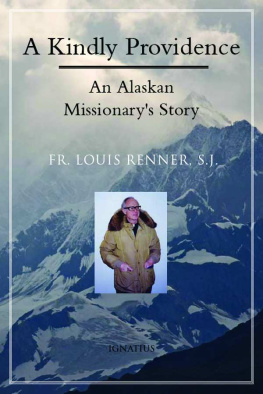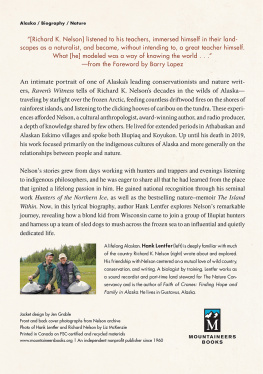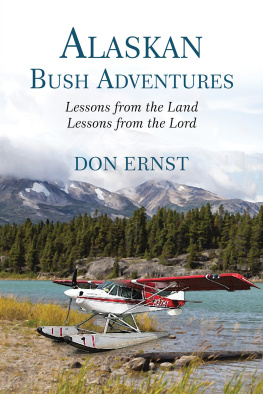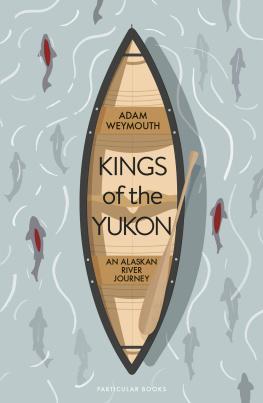A Kindly Providence
A KINDLY
PROVIDENCE
AN ALASKAN MISSIONARYS STORY
19262006
by
Louis L. Renner, S.J .
IGNATIUS PRESS SAN FRANCISCO
Cover photograph of Father Louis L. Renner
Cover design by Roxanne Mei Lum
2008 Ignatius Press, San Francisco
All rights reserved
ISBN 978-1-58617-236-7 (PB)
ISBN 978-1-68149-011-3 (EB)
Library of Congress Control Number 2007938141
Printed in the United States of America
Dedication
This autobiography,
A Kindly Providence ,
is dedicated to Saint Ignatius Loyola,
founder of the Society of Jesus,
who, having been brought by his Jesuit companions
to the realization that his life as an instrument
of Divine Providence was not exclusively his own,
favored posterity with his autobiography.
CONTENTS
PREFACE
When I first began to write an autobiographical sketch, it was my firm resolve that it be seen only by such as would outlive me. However, around 1995, when I made known to several members of my immediate family and a few close friends that I was roughing out an autobiographical sketch, they asked to see it. Somewhat reluctantly, I yielded. Among my close friends, I number Dr. Dorothy Jean Ray, my collaborator on the biography of Father Bellarmine Lafortune, S.J. (published in 1979). Upon receiving my autobiographical sketch, she intended at first, as she wrote me, merely to glance at it. However, as she further wrote me, Once I started reading it, I couldnt put it down. Once into it, I had to finish. So I finished the whole thing late that evening. Im so glad to have it. You have written in such a way as to bring yourself alive. We really get to know the inner man. She urged me to write a full-fledged autobiography. On April 11, 1986, she had already written to me: I trust that you had a wonderful Easter with all your Ruby parishioners. I hope that you are keeping notes about all your experiences as a bush priest. With all your trips and your interesting sidelights of life in Ruby, it would make a wonderful story for your autobiography or biography.
Fortunately, in retrospect, I was, at the time, keeping notes and making diarylike jottingsjust as I had all along in my priestly lifeof most of my more important doings, goings, and comings. In my favor, too, as an autobiographer, was the fact that I had retained much of a voluminous correspondence, as well as articles written by and about me. I also had in my possession copies of all the tapes and transcripts of interviews of me. When my fifteen-year career as a member of the faculty of the University of AlaskaFairbanks came to an end, the university, at my request, sent my complete personnel file to the Jesuit Oregon Province Archives. This was accessible to me, of course, as was an extensive photo collection to illustrate most aspects of my life.
Over the years, various readers of my writings encouraged me to write an account of my life. The editor of Extension Magazine editorialized in 1991: Perhaps someday a young Jesuit following in Father Renners footsteps will write a book about this dedicated Alaskan missionary. A former classmate, Father Armand M. Nigro, S.J., wrote to me before I left Alaska in the year 2002: My last advice iswrite a good biography of yourself, for the edification of young people for generations to come. Very Reverend John D. Whitney, S.J., father provincial of the Oregon Province of the Society of Jesus, during my annual colloquy with him on January 13, 2005, asked me, on his own initiative, to write my autobiography. A year later, he asked me how I was coming along with it and told me that he himself looked forward to reading it.
When, on April 17, 1991, Marjorie Van Cleve interviewed me as part of the University of AlaskaFairbanks Oral History Project, I told her that, given my naturally shy nature, I would rather write a thousand words than speak a hundred. I can honestly say that the writing of these many thousands of autobiographical words, a quasi-reliving of my past life, has been for me a truly pleasant, satisfying experience. May the reading of this autobiography be for readers likewise a pleasant, satisfying experience.
By way of acknowledgements: For reading the manuscript and making many invaluable comments and suggestions, I thank very sincerely Sister Margaret Cantwell, S.S.A., who had been my collaborator on Alaskana Catholica . I thank very sincerely also Father David J. Leigh, S.J., a former student of mine at Seattle Preparatory School who is a specialist in matters pertaining to autobiographies and the writing thereof. Father Leigh, providentially, was on sabbatical leave from Seattle University just when my manuscript was at the stage to profit most from his insights and suggestions, and he, therefore, having a little slack time, favored me with these at length. Without his generous input, A Kindly Providence would simply not be the autobiography that it is.
Likewise very sincerely, I thank also Michael Rorholm for putting his computer-related expertise so graciously and unstintingly at my disposal. I would also like to thank the staff and freelancers of Ignatius Press for their help in bringing this book to publication.
Before concluding my preface, I want to mention that Jesuit Fathers Jules M. Convert and James E. Poole need to appear, if only in passing, in this autobiography, inasmuch as their lives touched my life, and so are part of itthis, in spite of later allegations that they engaged in sexual misconduct with minors, as is stated in the respective entries concerning them in my Alaskana Catholica .
Louis L. Renner, S.J.
July 31, 2007
Feast of Saint Ignatius Loyola
Chapter 1
Childhood on a North Dakota Farm:
19261937
In June 1975, I found myself standing on top of Little Diomede Island in Bering Strait looking across several miles of water to Big Diomede Island and beyond to the Siberian mainland. Had I been able to make a leap of about twenty-five miles, I would have been on that mainland and able to travel cross-country all the way to the region just north of the Black Sea. There I would have been able to visit the burial sites of several generations of my great ancestors. From there, I would have been able to go still farther west, to the southwestern part of Germany, to visit more burial sites, of those many more generations of great ancestors. The sight of the Siberian mainland warmed my heart further, inasmuch as that landmass was the home also of former White Russia, to which I, as a Jesuit, owed a great debt of gratitude for allowing the Society of Jesus to exist in its domains when elsewhere it had been suppressed by papal decree in 1773.
I trace my more immediate ancestry on my fathers side as follows, beginning with Johann-Martin Renner. He was born of Catholic parentsas had been his ancestors of many generationsin Steinweiler, Palatinate, Germany, on May 30, 1766. In 1809, he emigrated to Karlsruhe, near Odessa in southern Russia. A few decades earlier, Catherine II, Catherine the Great, czarina of Russia (17621796), had invited German farmers to come to Russia to set an example of good farming for Russian farmers. In Karlsruhe, in 1818, Andreas, the son of Johann-Martin, was born. Andreas was the father of Joseph Renner, born on January 6, 1875, also in Karlsruhe. On May 3, 1893, Joseph, having sailed from Bremerhaven, Germany, arrived in New York. A year later, he settled on a farm eight miles due west of Saint Anthony, North Dakota. Josephmarried, in 1898, to Margaretha Forsterwas the father of John Joseph Renner, my father, born in Saint Anthony on September 19, 1899.
The ancestors on my mothers side, the Gustinslikewise Catholic for many generationscame originally from the same area of Germany as did the Renners and similarly immigrated to the same general area in Russia as did the Renners. Lorenz (Lawrence) Gustin, my mothers father, was born on July 7, 1860, most likely in Karlsruhe, Russia. Margaretha Rther-Gustin, my mothers mother, was born in Karlsruhe on March 1, 1862. They were married on January 25, 1882, in Halbstadt, Russia. For nineteen years, they lived in Russia, presumably in Halbstadt. Meanwhile, their friends and relatives were selling their properties and immigrating to the United States. Reasons given for the emigration were that farmland for the growing families was getting harder and harder to come by and young men were beginning to be conscripted to serve in the Russian military. By early December 1901, the Lawrence Gustin familyconsisting now of the two parents plus seven boys and two girlswere in Fallon, North Dakota. The following year, they settled on a homestead four miles northeast of Flasher. (Fallon and Flasher, about four miles apart, are some thirty miles southwest of Mandan-Bismarck. Saint Anthony is halfway between them.) It was on that homestead that, on January 6, 1904, my mother, Rosa (Rose), the last child to be born to that family, came into this world.
Next page







